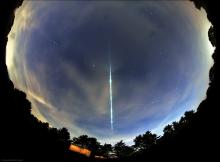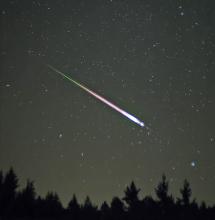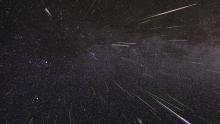Listen to today's episode of StarDate on the web the same day it airs in high-quality streaming audio without any extra ads or announcements. Choose a $8 one-month pass, or listen every day for a year for just $30.
You are here
Quadrantid Meteors
The Quadrantid meteor shower should be at its best tonight. Unfortunately, “best” doesn’t mean great. That’s because the last-quarter Moon gets in the way. It’s in view during the expected peak hours, so its glare will wipe out all but the brightest meteors.
The shower is named for an extinct constellation – the wall quadrant - an instrument that astronomers used for centuries to track the positions of stars. That region of the sky is in Boötes the herdsman, near the handle of the Big Dipper.
The Quadrantids appear to come from a trail of dust left by an asteroid or dead comet. As it orbits the Sun, it sheds bits of rock and dirt. Today, the parent body’s orbit doesn’t cross Earth’s orbit. But it must have in the distant past. That left a trail of debris for Earth to pass through.
As we cross the trail, some of the debris hits the atmosphere at about 90,000 miles per hour. The particles vaporize, forming the streaks of light known as meteors or shooting stars.
The Quadrantids include quite a few “fireballs” – especially bright meteors that can explode. They’re formed by larger bits of debris – the size of pebbles. They can be bright enough to see through the Moon’s glare. And a few fireballs are usually seen for a few nights after the shower’s peak.
Look for the meteors in the wee hours of the morning. You might see up to a few dozen of them – blazing bits of rock and dust high in the sky.
Script by Damond Benningfield





